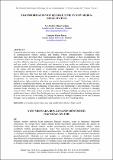- DSpace Home
- →
- Web Of Science
- →
- Web Of Science
- →
- View Item
JavaScript is disabled for your browser. Some features of this site may not work without it.
| dc.contributor.author | Yengin, Deniz
|
|
| dc.date.accessioned | 2024-03-26T11:19:38Z | |
| dc.date.available | 2024-03-26T11:19:38Z | |
| dc.date.issued | 2016 | |
| dc.identifier.issn | 2146-5193 | |
| dc.identifier.uri | http://hdl.handle.net/11547/11435 | |
| dc.description.abstract | Communication has been in existence since the beginning of human history. It is impossible to think of communication without humans, and humans without communication. Throughout time, individuals have developed their communication skills. By obligation to these developments, the environment where the message is tranferred also changes. Media is updated everyday with technical novelties. Bolter's statement each improvement is a mediation models the transformation in media and new media. Content, relationships and interaction in new media are mediations, while what concerns systems and technology is considered as remediation. The increase in content and interaction in the media, and the update of relationships creates mediation. The transformation in the technological substructure of the media is expressed as remediation. The most obvious example to give is television. Television has had a linear communication process as a conventional media tool. However, television has undergone the processes of remediation and mediation, where it has now incorporated an interactive structure. With characteristics such as internet, 3 dimensions, digitalization, high resolution, television can now be characterized as 'smart'. Technology, which is defined as socialized information, has turned television into an interactive system. Due to this novelty, television watching habits are changing. In this context, new terminology is also emerging. This study examines binge watching, as a new television watching habit as a result of television's changing characteristics. This study further examines the concept of binge watching according to the uses and gratification theory, where New Media practices have transformed television show watching patterns as a free time activity. In the study, the concept is discussed through a literature review and evaluated through a survey prepared to understand individual television show watching habits. | tr_TR |
| dc.language.iso | en | tr_TR |
| dc.title | TRANSFORMATION OF LEISURE TIME IN NEW MEDIA: BINGE WATCH | tr_TR |
| dc.type | Article | tr_TR |
Files in this item
This item appears in the following Collection(s)
-
Web Of Science [958]
